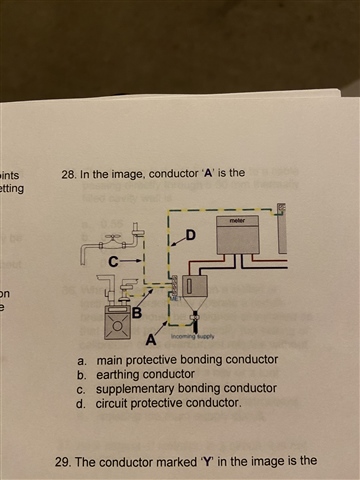 hi started to study for my 18th, wots you guys think the answer is, something tells me it’s different to wots on the answer sheet
hi started to study for my 18th, wots you guys think the answer is, something tells me it’s different to wots on the answer sheet
Bonding is generally reserved to describe connexions things that are not part of the circuit primary ADS path, so the ones to the tap and the gas meter, This Q refers to is a main CPC if you like. In the common vernacular the main earth wire.
MET is often said to be where bonds and CPCs meet, but that is often inside the CU, rather than at a marshaling block as here.
M.
Presuming what they're showing you is the origin of the installation and the terminal block is the MET, then I'd agree A is indeed an Earthing Conductor by BS 7671 definitions.
(On the other hand if it were say a supply to an outbuilding with say a landlord's meter, it could be classed as a c.p.c. for the submain)
- Andy.
Good for you!
That diagram is a little old-fashioned. There, the supply is TN-S, which is shown by the clamp around the (lead-sheathed) service cable, which connected to the MET by the earthing conductor (A).
Nowadays, services tend to be in plastic pipe so there is no requirement for main protective bonding so B and C would not be required. The supply is likely to be TN-C-S (PME) so the earthing conductor comes out of the service head. There is no requirement for the MET as shown and the earthing conductor goes straight to the distribution board. The MET is now the earth terminal bar in the DB and they typically have provision for bonding conductors.
If you put that all together, the earthing conductor would be A and D so I can see how they have made their mistake.
If you have a traditional MET by the service head, and a cable from there to the DB, I am not sure what cable D is called. It does not match the definition for a circuit protective conductor, an earthing conductor, or a bonding conductor. I think that you could simply call it a "main protective conductor", but many people would probably regard it as (part of) the earthing conductor.
I don't want to confuse you, but sometimes when there is a submain between buildings, its protective conductor joins two terminal strips of the same type as a traditional MET. You can have only one MET, but the one in the second building serves the same purpose. As Mike says, it could be known as a "marshalling terminal", but I prefer "building earth terminal".
HTH.
I think D and A are the same conductor, namely the big CPC for the whole site - I'd not use any term with 'bond'' in the name. The fact it has a MET (Main or Marshalling Earth Terminal )part way along does not alter the primary function of being the thing the ADS in the consumer unit depends on - cut either and you cannot be sure that fuses blow any more.
The plumbing bonds could have joined at the CU end or at the incomer end and not alter that.
Equally I'd not say someone was wrong if they referred to either A or D as the "main earth" - just as long as they did no slip in the word 'bond', . not a question with clear cut 'always right' answer so rather a nasty one.
Mike.
Agree - its a perfectly sensible place to expect an informed-ish answer from folk who move electrons around for a living, and are one step removed from the
'don't ask, just memorise the right answer and pass' mentality of some more exam cramming hassled tutors.
The only risk is that he gets a more complex answer than can be easily digested. Equally this is not a 'do your homework' service, so some user input is expected as well - withing those bounds, the right place I'd have thought. It is arguably even a wiring question, rather than some of the more diverse stuff we see shunted to other parts of the forum.
Mike
but why ask here?Why not?
Andrew has given a perfectly sensible answer - he has not yet got a tutor.
Andrew, if you hang around in here, you can learn quite a lot.
We're about to take you to the IET registration website. Don't worry though, you'll be sent straight back to the community after completing the registration.
Continue to the IET registration site